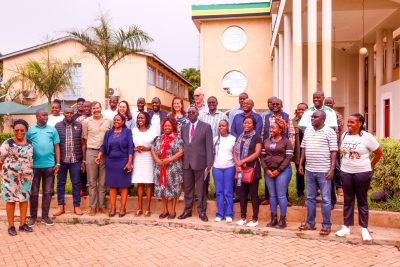 The County Government of Siaya, through the Department of Water, Environment, Climate Change, and Natural Resources, held a Nature, People, and Climate Program briefing with several stakeholders, including NEMA, the World Bank, Kenya Forestry, Nature Kenya, the State Department for Environmental Change, Planet Fund, and Net-Fund.
The County Government of Siaya, through the Department of Water, Environment, Climate Change, and Natural Resources, held a Nature, People, and Climate Program briefing with several stakeholders, including NEMA, the World Bank, Kenya Forestry, Nature Kenya, the State Department for Environmental Change, Planet Fund, and Net-Fund.
The meeting that was led by the Chief Executive Committee Member (CECM) for Water, Sanitation, Environment, Climate Change, and Natural Resources, Prof. Jacquieline Oduol, along with the County Climate Change Coordinator, Melkizedek Odhiambo, the Director of Agriculture, Eliakim Ambajo, and the Director of Public Participation, Jared Abayo, provided an overview of the status of the environment and natural resources, focusing on forestry, wetlands, farming, the extent of degradation, and opportunities for restoration.
NEMA County Director Kipkoech and the Regional Coordinator, Ms. Stella Kamwasir, highlighted the major wetlands in the county, which include Lake Victoria, Lake Kanyaboli, Lake Sare, Lake Namboyo, Yala Swamp, and Anyiko Wetland. Additionally, several smaller wetlands are spread across the county, including Sirombi in Alego Usonga Sub County, Tartro in Gem Sub County, and Kadiero in North Sakwa, among others. They emphasized that these wetlands play a crucial role in providing ecosystem services such as flood control, water quality improvement (water purification), shoreline and riverine erosion control, provision of natural products, habitat for diverse fish, birds, and other animals, food for local communities, groundwater recharge, carbon sequestration, and serving as sources of water for agriculture, recreation, and aesthetic enjoyment.
Mr. William Ojijo, the County Director of Kenya Forestry, addressed the current state of forest cover in Siaya County. He mentioned that the total land area under gazetted forests is 462 hectares, comprised of Got Ramogi and Got Abiero forests. The total area under community forest trust land is 1,010.33 hectares. He further stated that the county ranks among the lowest in terms of forest cover, with a percentage cover of 0.23% and tree cover at 5.27% (18,676.37 hectares). He underscored the importance of forests in protecting water catchment areas and providing other ecosystem services.
Under the 15b tree-growing program, Siaya has been allocated the responsibility of growing 149,049,908 trees across 149,050 hectares by 2032, a move aimed at increasing the forest and tree cover in Siaya County. The county government, in partnership with the World Bank, the National Government, and Net Fund, has agreed on a joint mission to formulate and implement a framework policy to address the severe environmental effects and degradation primarily caused by human activities related to socio-economic issues, such as pollution, unsustainable land use, agrochemicals, illegal tree cutting, soil erosion, and private ownership of hilltops. These activities contribute to climate change, land degradation, loss of vegetation cover, and biodiversity.
The proposed interventions aim to secure environmental flows to ensure water and air quality, as well as the restoration and protection of forests, riparian areas, and wetlands. This includes promoting nature-positive and climate-resilient practices in cultivated areas and rural livelihood resilience practices. Key strategies include climate change mitigation, positive outcomes for biodiversity, sustainable farming methods, carbon credit systems, aligning existing programs and policies with partners, enforcing mining regulations, creating awareness of environmental conservation among community members, and delineating and marking wetland boundaries. Siaya County is currently in the advanced stages of forming a county environment committee, which will provide a common framework for the National Government to address these climatic issues. Residents of Siaya are also encouraged to plant more trees and avoid environmental pollution.
